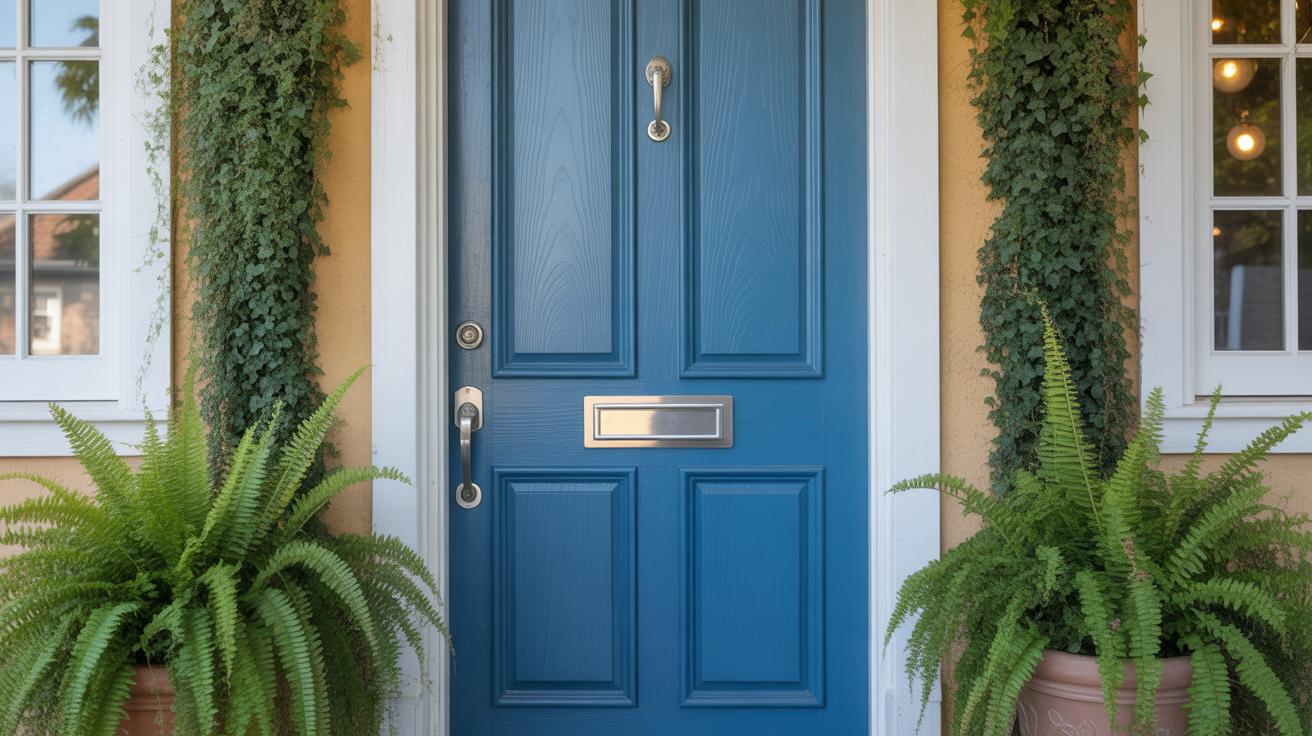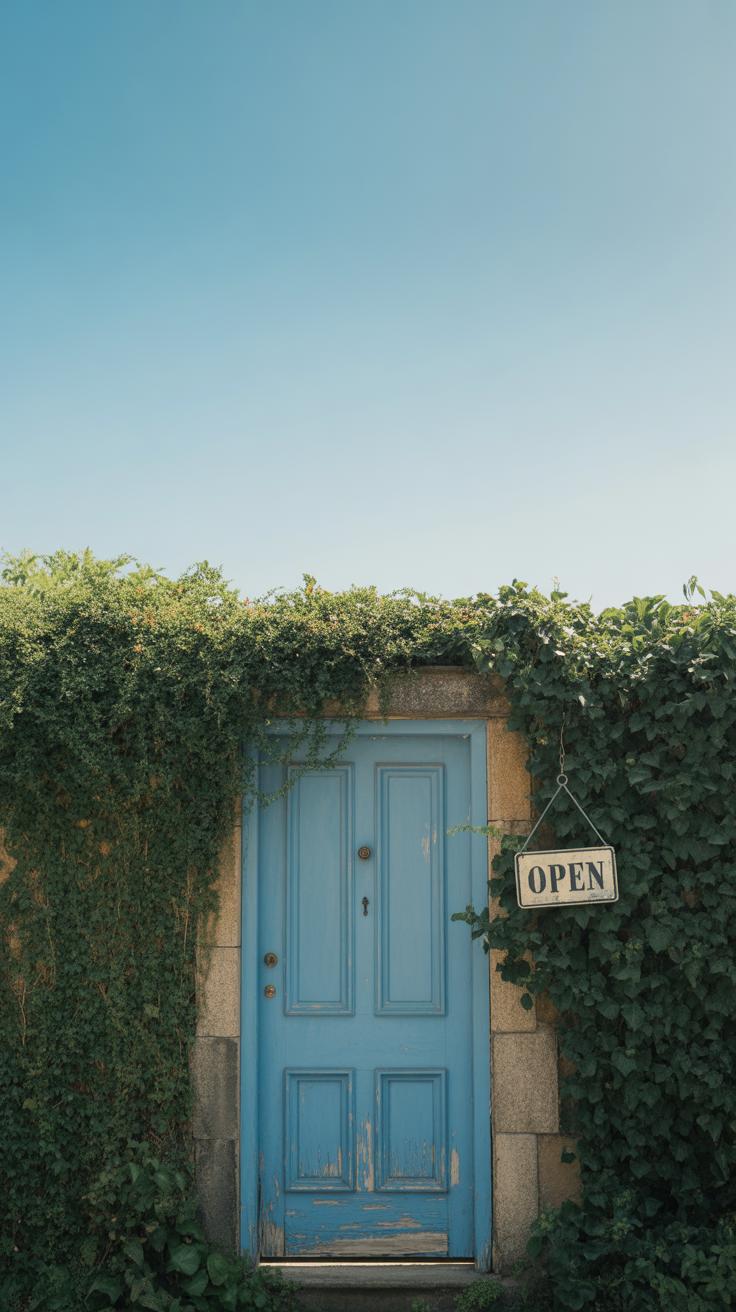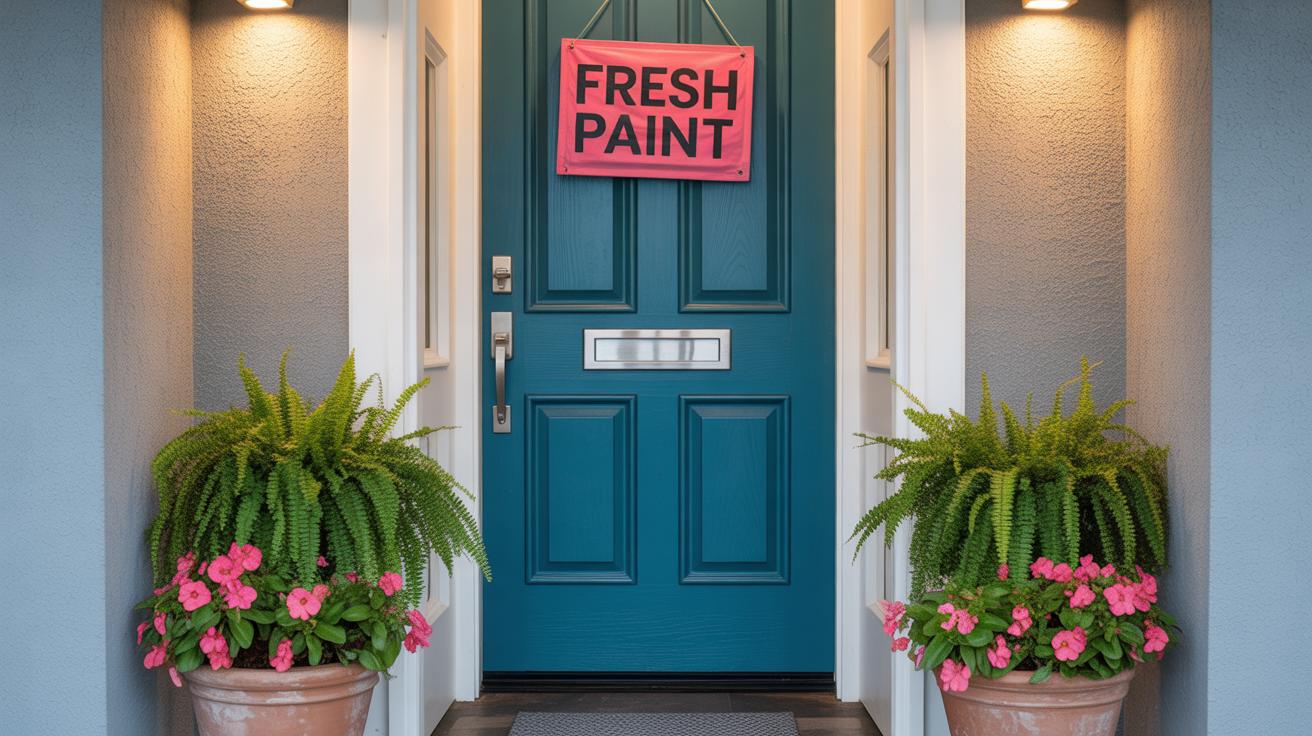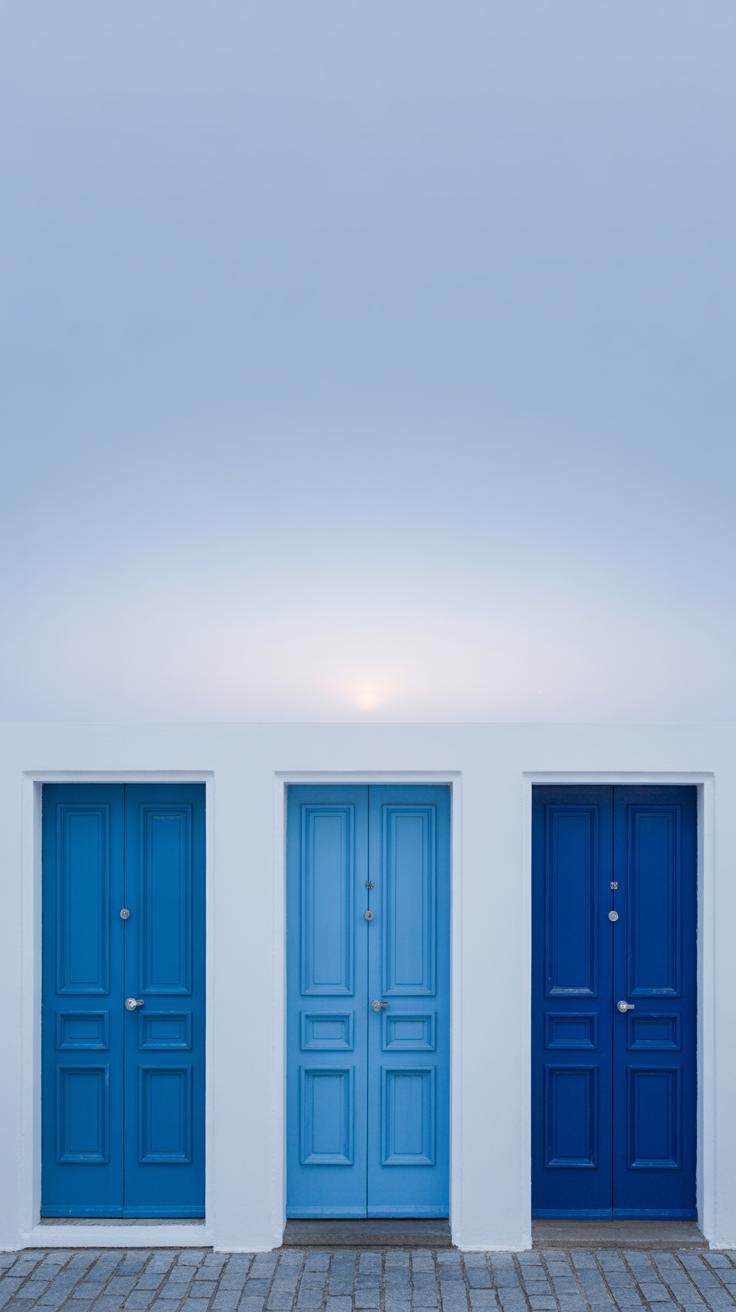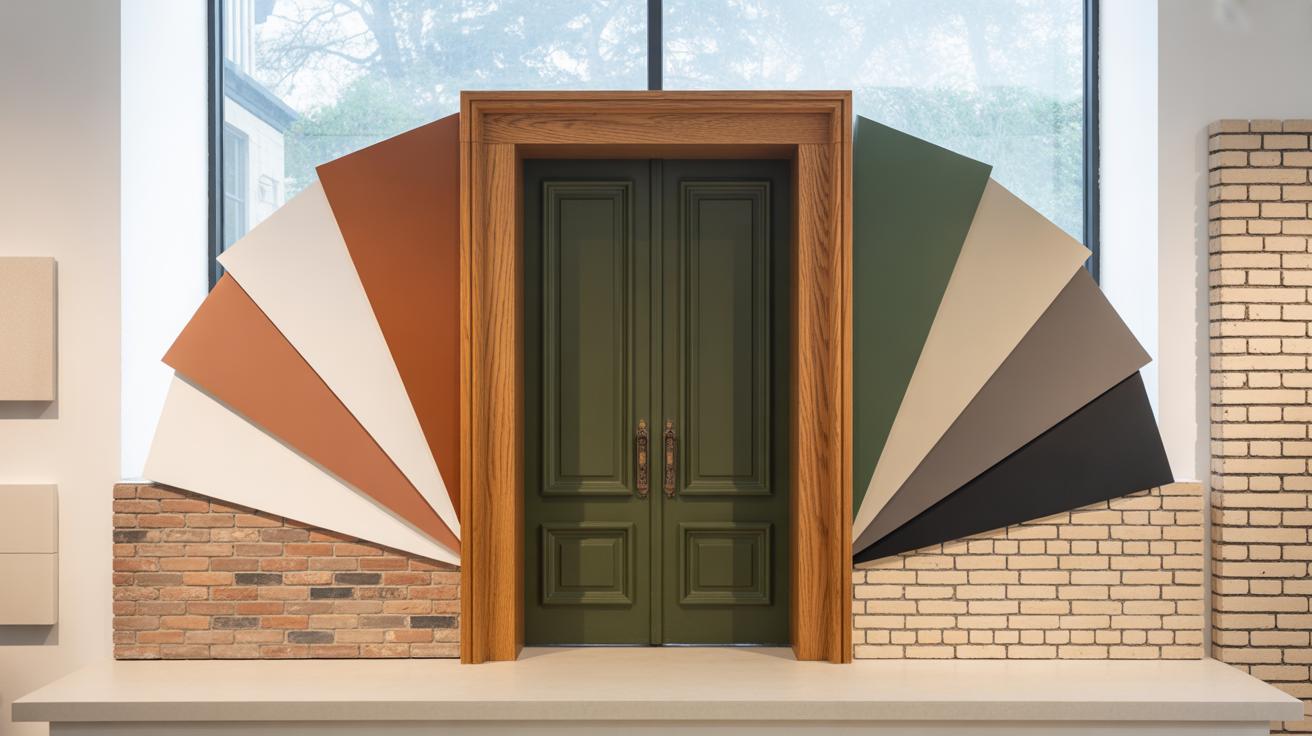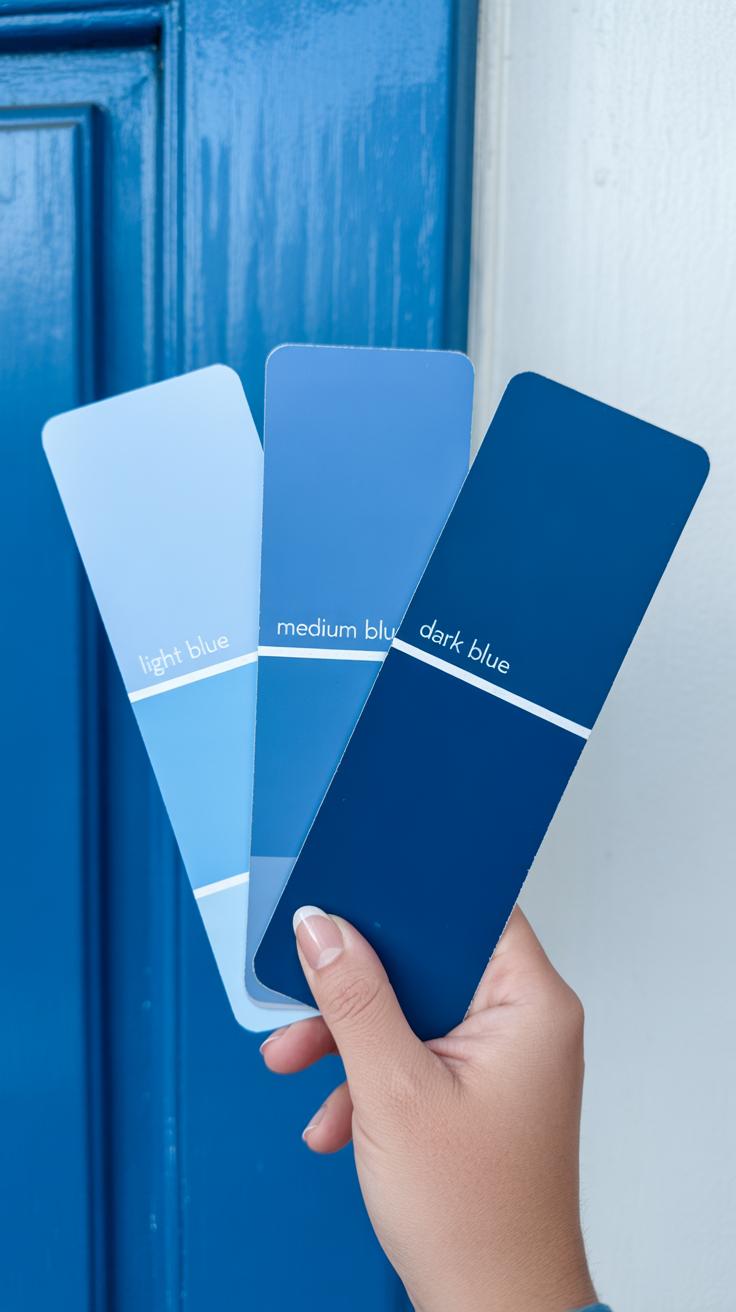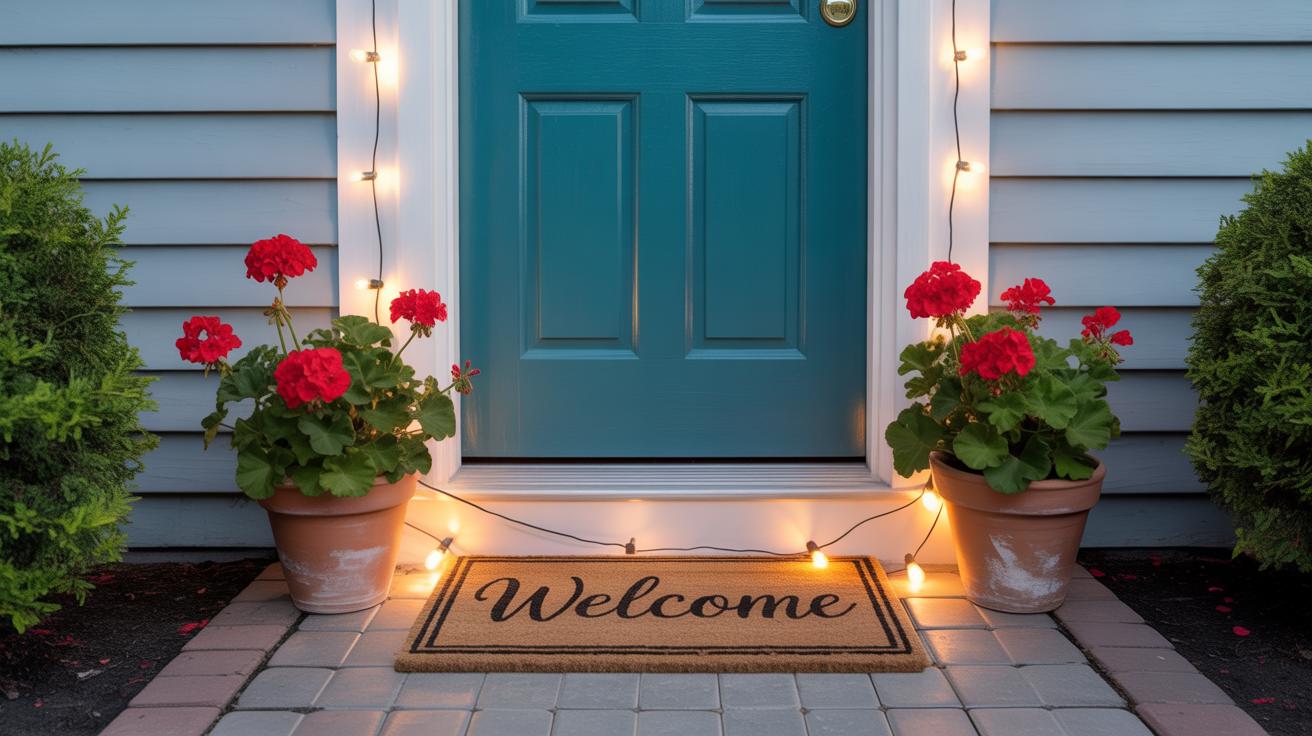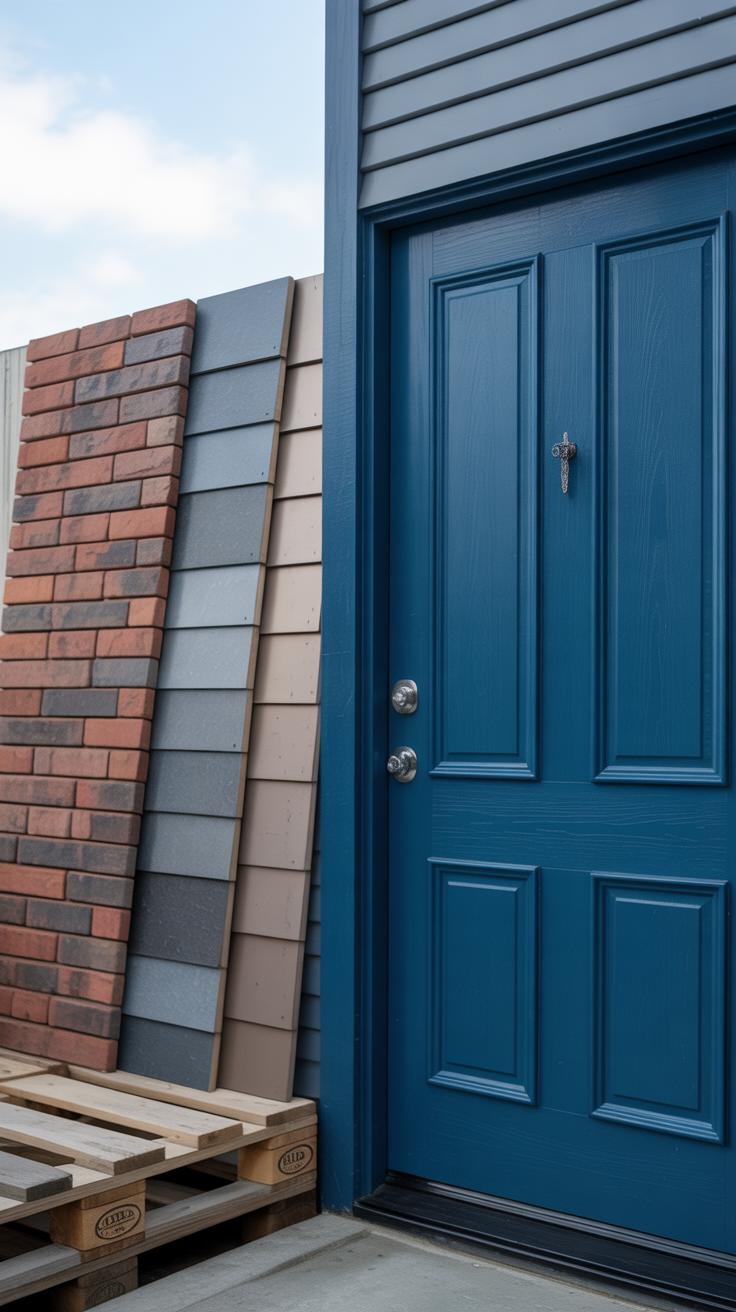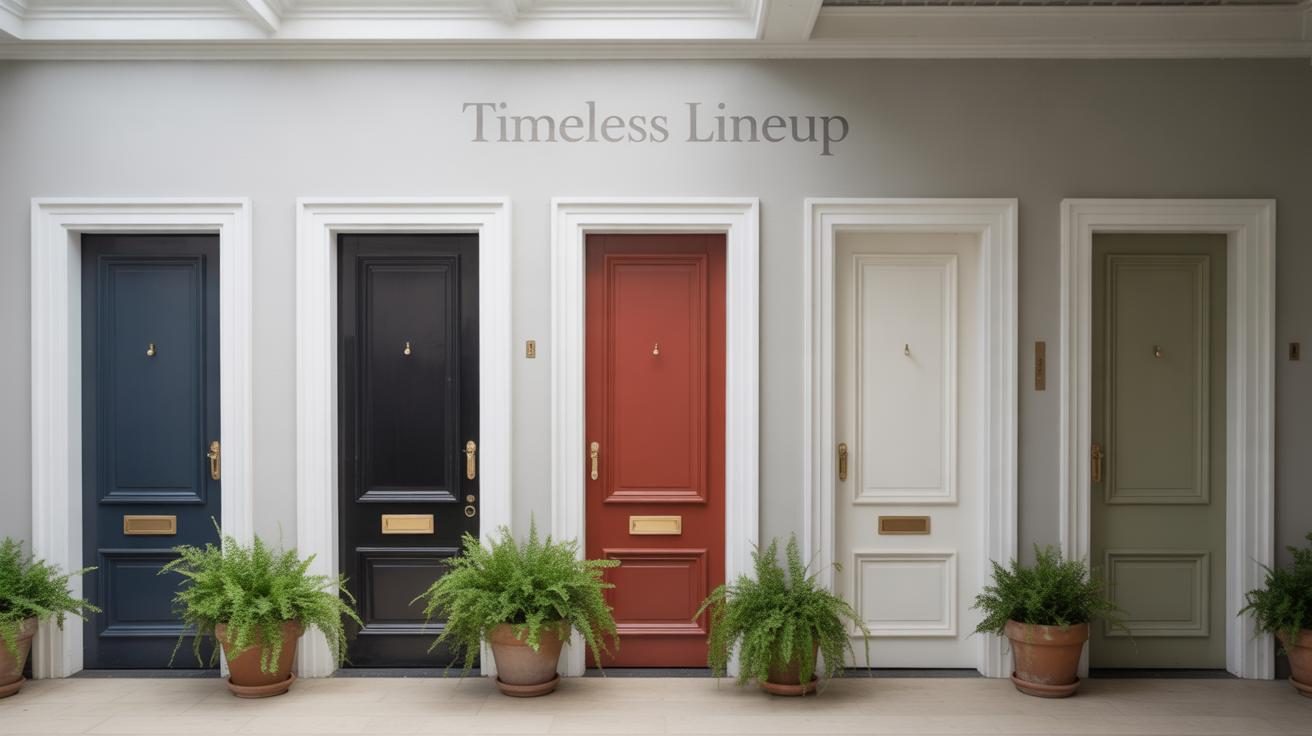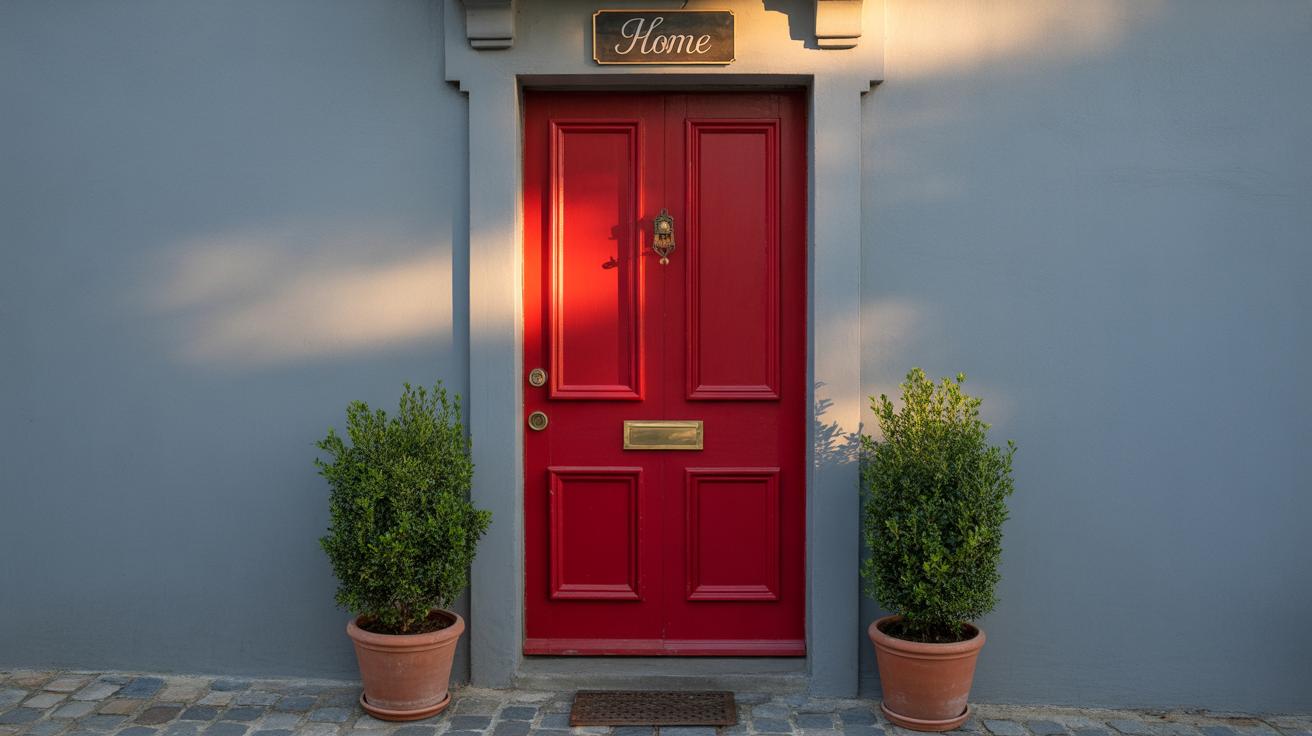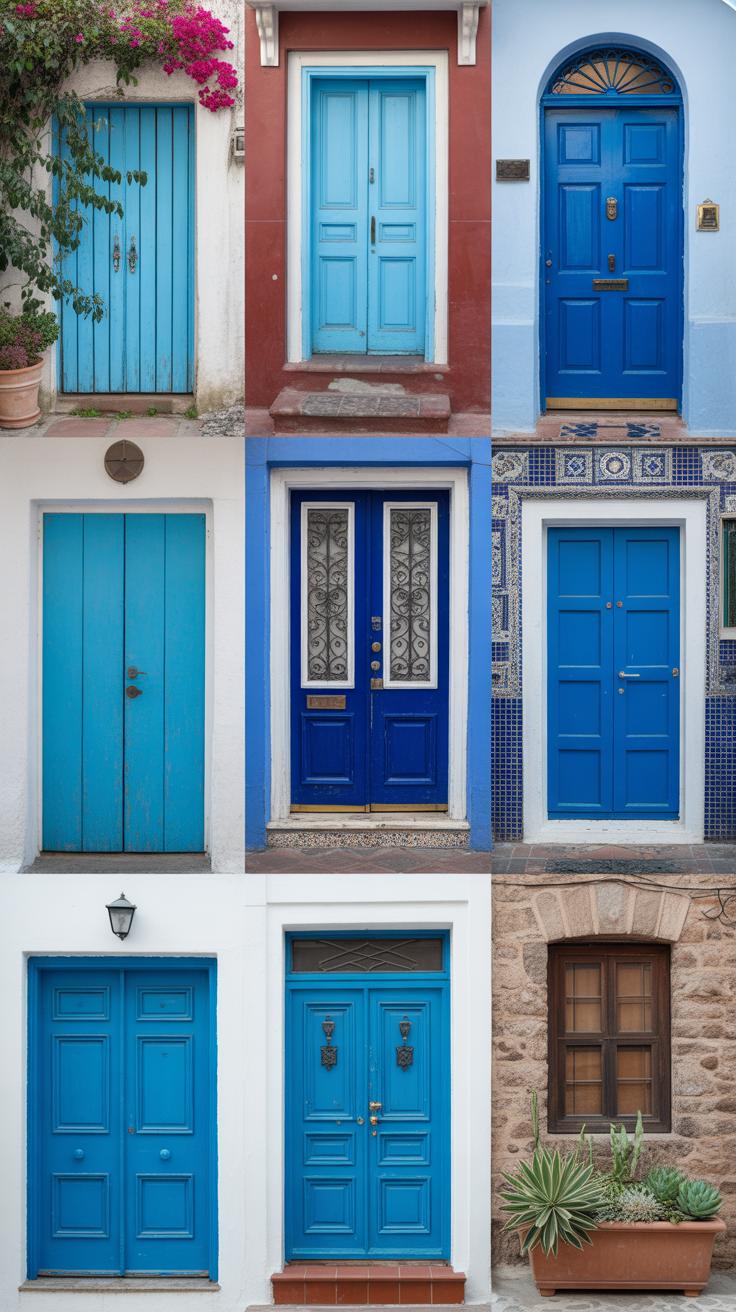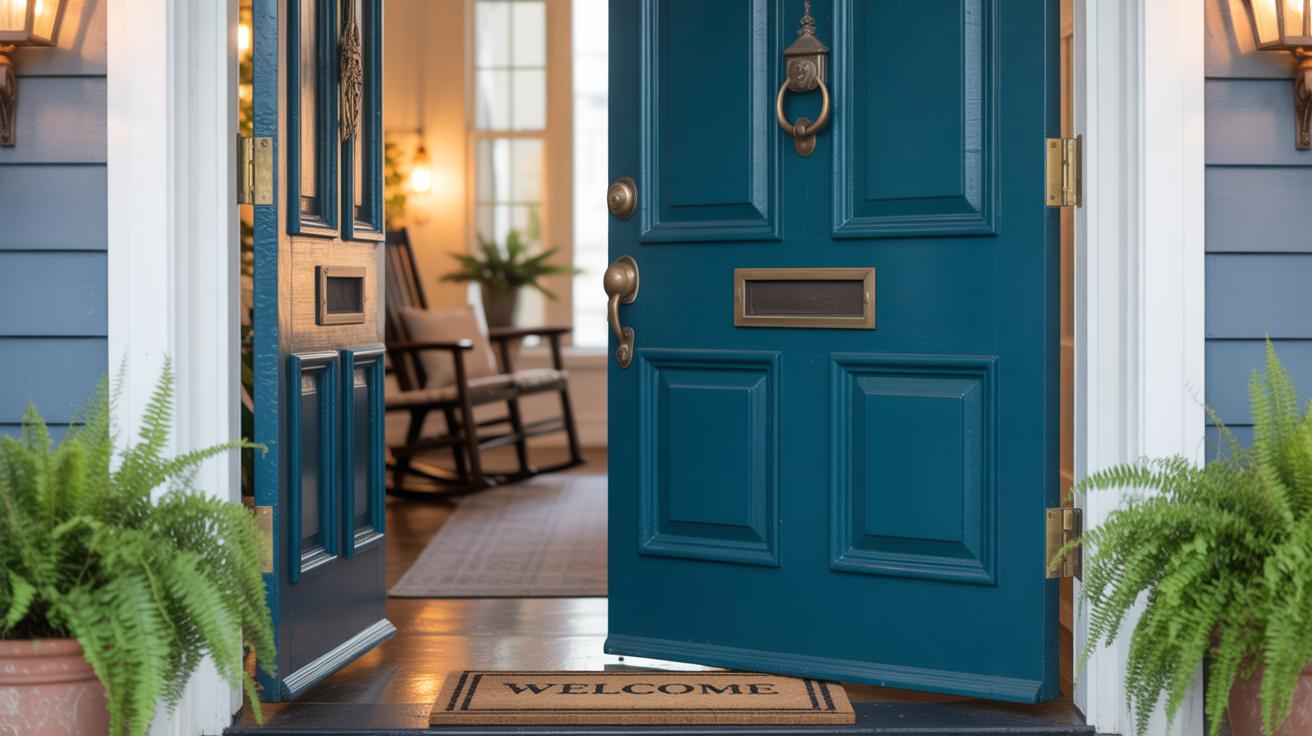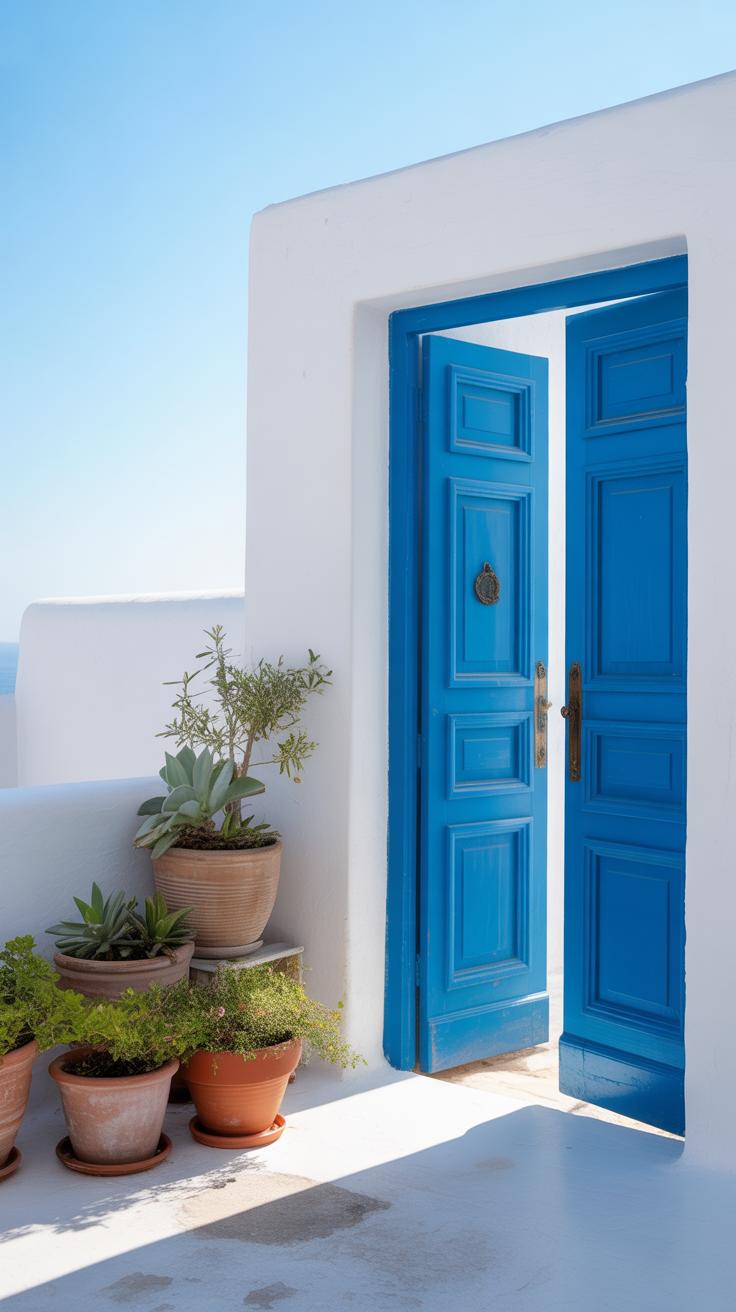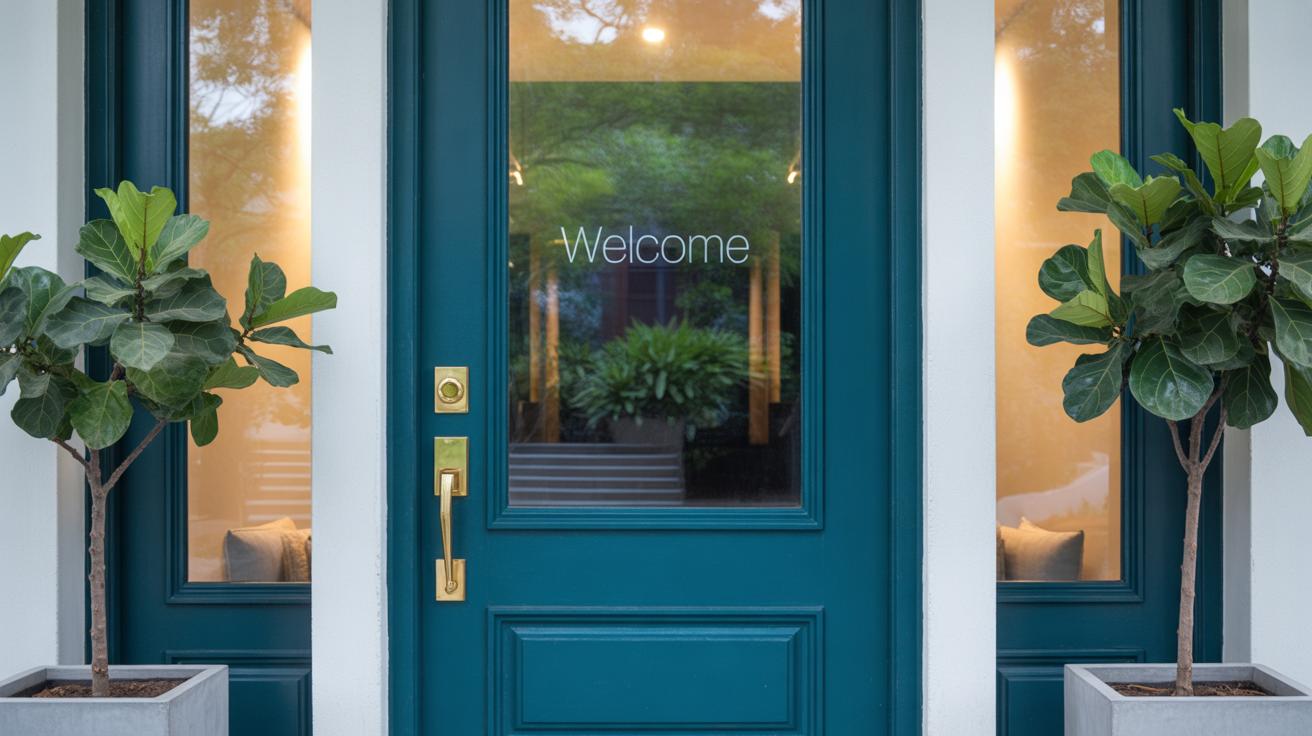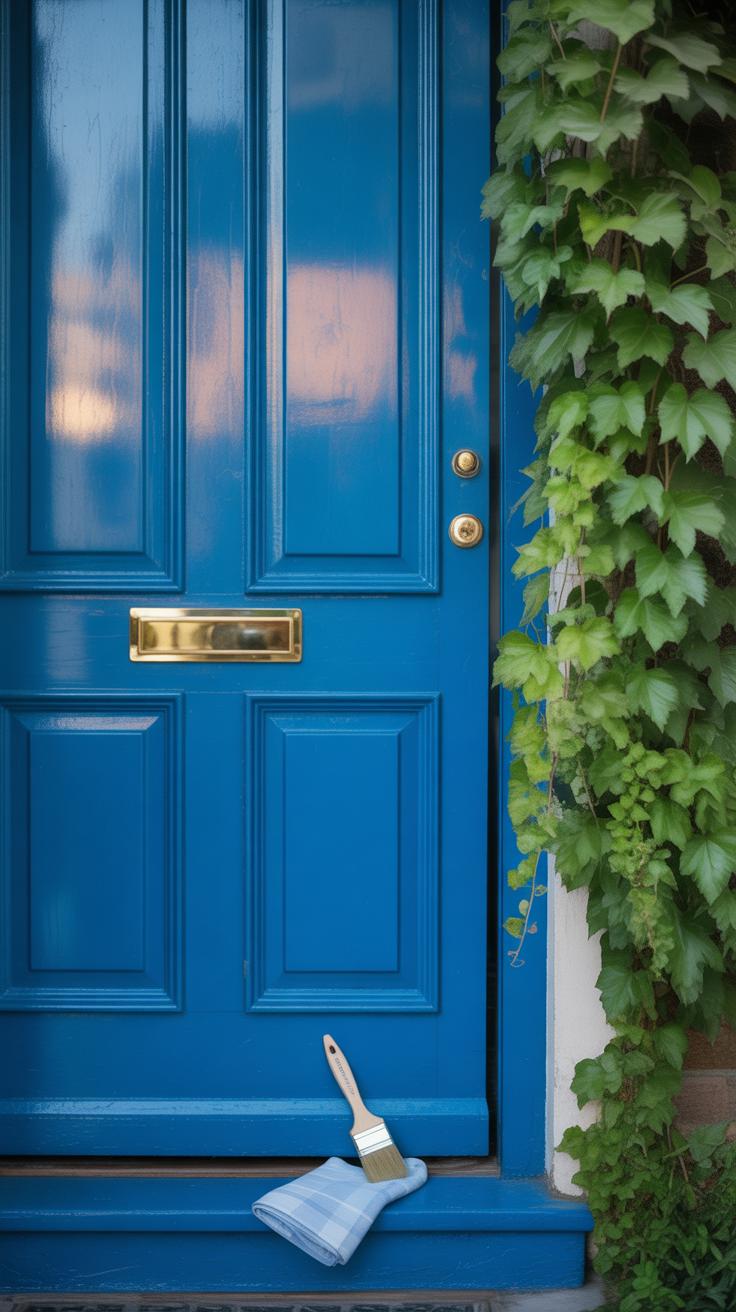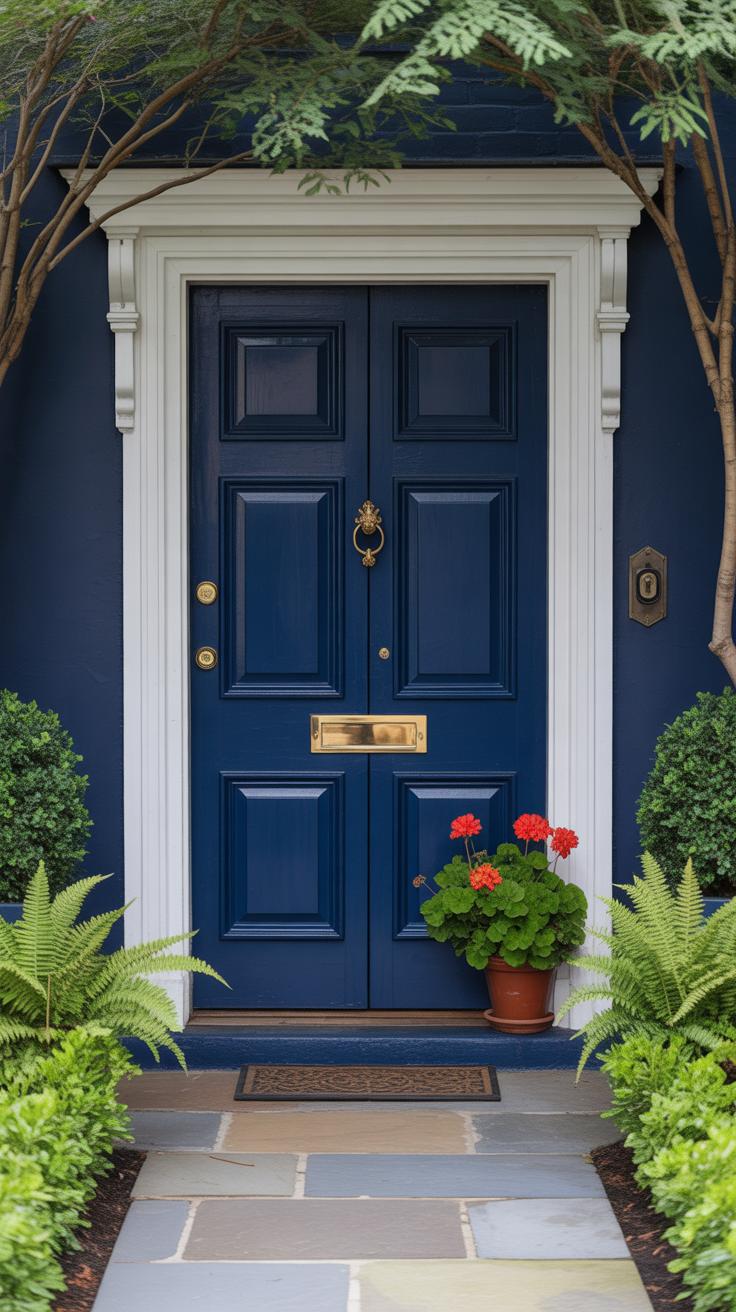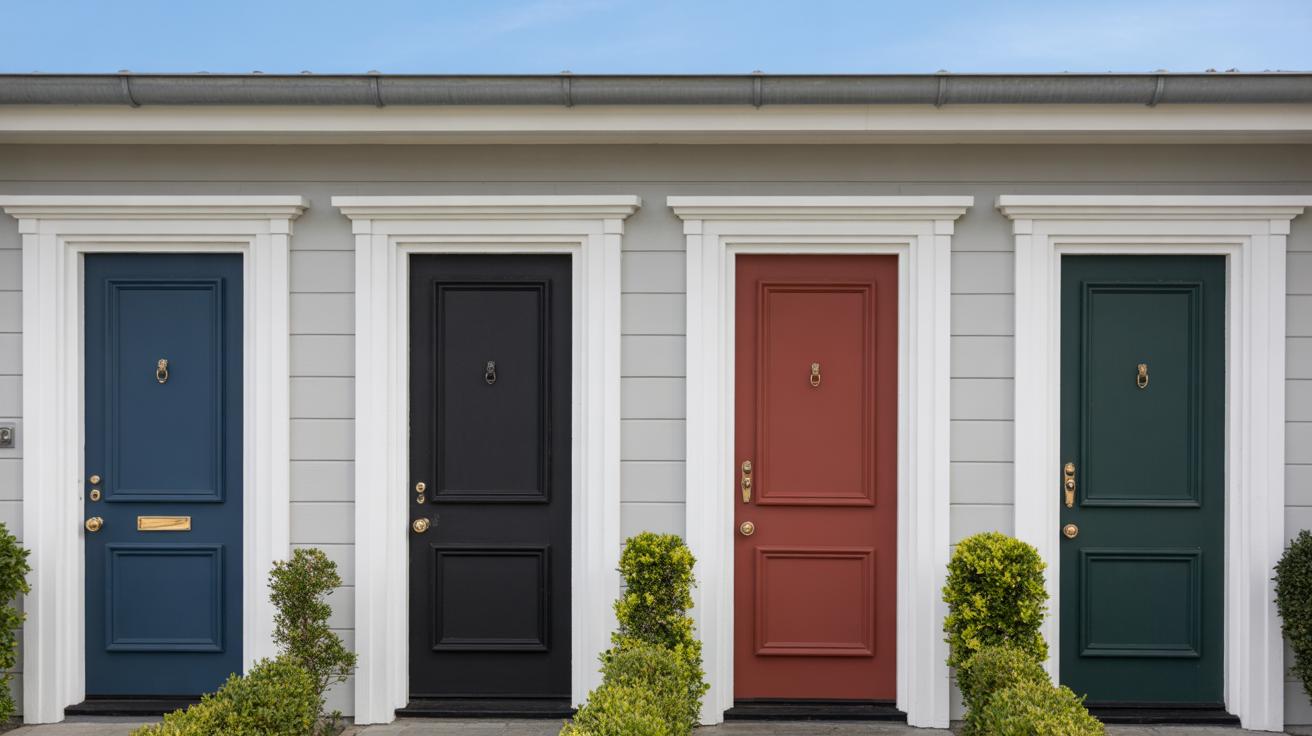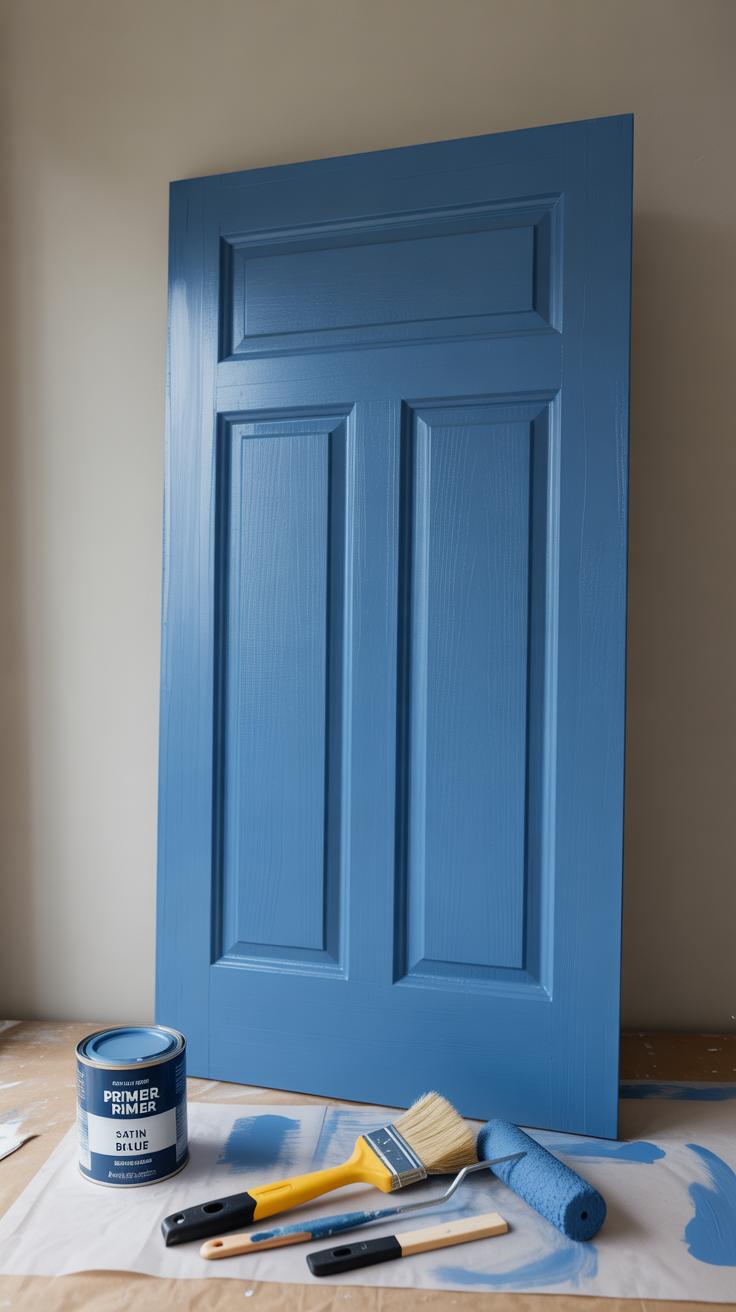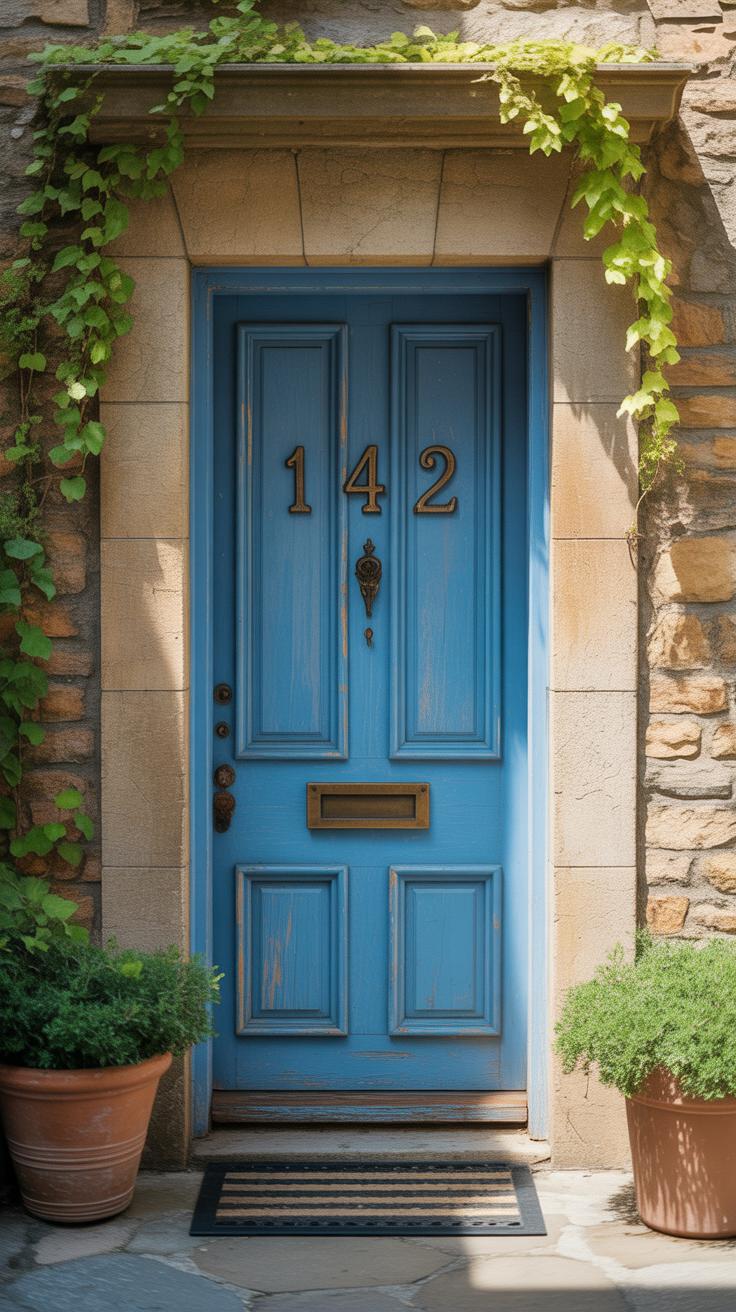Introduction
Choosing a blue front door can change the look of your home and say a lot about your personality. Blue is a color people often connect with calmness and trust, making it a great choice for creating a welcoming entrance to your space. Many homeowners pick blue doors to add a touch of peace or to reflect a classic style.
This article will guide you through the meanings of blue front doors and give you ideas for the best blue shades to try. You will learn why so many people love blue doors and how to pick the shade that works best with your home design and personal taste.
What Does a Blue Front Door Symbolize
Blue front doors have this quiet way of suggesting a certain feeling even before you step inside. They often stand for calmness and peace, which might explain why so many homeowners choose them. Imagine arriving at a house where the front door is a soft sky blue—doesn’t that invite you to slow down, breathe a little, maybe even feel settle in? This color tends to make spaces feel more serene, creating a welcoming atmosphere that gently puts visitors at ease.
Culturally, blue can carry different meanings, but for homes, it often aligns with tranquility and a grounded kind of comfort. Some people say it connects with the idea of protection, like a calm shield in the unpredictable world outside. Psychologically, blue taps into our senses in ways that feel reassuring.
When you see a blue front door, you might not realize how much it signals trustworthiness and reliability. Blue is frequently linked to these qualities—the kind of traits you’d want to associate with your home or even yourself as an owner. It suggests a place where promises are kept and where people matter. It’s funny, though, because while some blues feel stable, others might come off as distant or cold. So, the way blue is perceived can vary, depending on shade and context.
Thinking about your own front door—does the idea of a blue door make you feel steadied? Or does it seem a bit too quiet, maybe? These mixed reactions show how subtle and personal the symbolism can be.
- Blue doors often exude peacefulness and calm, making homes feel inviting and restful.
- They can suggest protection, creating a sense of safety before even entering.
- Trustworthiness and reliability are key traits connected to this color in a home setting.
- Cultural interpretations vary, so your experience with blue may be unique.
Color Psychology Behind Blue Doors
How Blue Affects Emotions
Blue has a curious way of affecting our moods. It’s often linked to calmness, and many studies suggest it helps lower stress and anxiety. When you walk past a blue door, you might feel a slight sense of peace, like a soft pause in a busy day. It’s not always dramatic, but the effect lingers. Some research points out that blue slows heart rates and calms the nervous system, which could explain why it’s a go-to for places meant to welcome and soothe.
Yet, it’s not just about calm. Blue can also inspire focus and clarity. Maybe that’s why people pick it for workspace walls or bedrooms. But in the case of the front door, that sense of calm invites visitors to feel at ease before they even step inside. Still, blue’s emotional pull isn’t the same for everyone; cultural background and personal experience can change how you respond to it.
Choosing a Blue Door to Send the Right Message
Picking a blue door isn’t just about liking the color. It can say something about who you are and what you want your home to express. Because blue tends to communicate trust, stability, and friendship, a blue front door might suggest that you’re welcoming but steady, open to visitors but with boundaries.
Think about these messages a blue door might send:
- You value peace and order, making your home a refuge from outside chaos.
- You’re reliable, someone people can count on.
- There’s a quiet confidence rather than a loud statement.
- You want your home to feel calm but approachable, not cold or distant.
But maybe you want to rethink this if you’re aiming for warmth or excitement in your entryway — blue might not be the best fit for that mood. Still, a blue door often hints at thoughtfulness, a kind of invitation to pause and connect.
Best Blue Shades to Try for Your Front Door
Classic Navy Blue
Navy blue is a deep, rich shade that rarely goes out of style. It carries a certain weightiness—almost a quiet confidence—that makes it appealing for a front door. You might think of it as solid and dependable, yet it also brings a touch of elegance without being flashy.
This shade tends to suit traditional and colonial-style homes, as well as those with brick or stone façades. It pairs well with white trim, adding a crisp contrast that highlights architectural details. But navy isn’t just for older homes; it can anchor modern designs, especially when mixed with sleek metal or glass elements.
There’s something about navy that feels grounded, perhaps even a bit serious. It commands presence at the entrance without shouting. I find it often gives the impression that the residents value heritage and stability, though you could easily argue it’s a bit more formal than some prefer for everyday charm.
Bright and Cheerful Sky Blue
Sky blue conveys freshness and lightness, like taking a deep breath on a clear day. It’s a playful, upbeat shade that can immediately brighten the entryway. This tone often works wonders on modern homes or coastal-style houses where a lighter, breezier feel is welcome.
Sky blue doors can soften stark exteriors, especially those with white or sandy tones. It also complements natural wood or soft gray sidings, mixing calmness with a dash of joy. Yet, sometimes it might seem a little too casual for those aiming for a statelier look.
I’ve noticed sky blue seems to invite friendliness. It’s as if the door itself invites you to come in and stay a while. But does that always fit every neighborhood? Perhaps not. Still, for spaces craving a little sunshine, it’s a shade worth trying out.
How to Pick the Right Blue Shade for Your Home
Choosing the perfect blue for your front door can feel a bit tricky. There’s a wide range—from icy, pale blues to deep navy—and the right choice depends on your home’s style, colors, and even the neighborhood vibe. Think about your exterior colors first. A bright, bold blue might clash with softer shades on your siding, while a muted, grayish blue could get lost against a neutral backdrop.
Try to balance the door with other elements like trim and landscaping. For example, if you have white trim, a crisp cobalt could really pop without overwhelming. But if your trim is darker or more natural wood, a softer steel blue might blend better.
Match Blue with Exterior Colors
Coordinate your blue door with what’s already there. Here’s a rough guide:
- Warm-toned siding like beige or cream often pairs well with blues that have a slight gray or muted undertone.
- Cool-toned exteriors, such as gray or white, can handle both bright and navy blues—sometimes it’s about what mood you want to set.
- Bold contrasts work nicely, too, like a vibrant blue door on a brick or stone exterior, but it depends on the neighborhood—jarring contrast can feel out of place in some areas.
You might wonder whether a too saturated blue door will clash with green surroundings or trees nearby—that’s often true. The best way is to get a few samples on the door itself, not just the wall.
Consider Lighting and Door Material
Don’t forget how light plays into color perception. A blue door in full sun will look different than one in deep shade. Materials also change things. For instance, a glossy finish on wood can make blues look richer and deeper, whereas a matte finish might soften the shade or make it appear dusty.
Test several samples at different times of the day. I once picked a beautiful blue on a cloudy day, only to find it had a greenish tint in the bright afternoon sun. Also, try swatches on the actual door material because paint tends to behave differently on metal than on wood or fiberglass.
It’s a bit of trial and error, but when you find the shade that works in your light and with your textures, the result feels natural—even if you weren’t sure at first.
Blue Front Doors in Different Cultures
Blue front doors carry deep cultural meanings that go well beyond their aesthetic appeal. In many parts of the world, blue is seen as a color that connects the physical and spiritual, offering protection and a sense of calm. For example, in Mediterranean countries like Greece, painting front doors blue is believed to ward off evil spirits. The famous blue doors of Santorini aren’t just charming—they are thought to guard the home from danger. It’s a tradition rooted in folklore, suggesting that blue stops negativity from crossing the threshold. Whether you fully buy into that or not, the idea feels comforting.
In parts of the Middle East, especially in Morocco, blue doors symbolize safety. Some neighborhoods use the color blue on doors and windows to invoke tranquility and secure the household from harm. It’s not just symbolic of protection but also a subtle signal that the home is a peaceful place amidst a bustling environment.
Blue doors can also reflect hospitality. In some Southern U.S. states, for example, a blue front door traditionally means “welcome,” signaling to visitors that the household is open and friendly. This friendly message isn’t just about openness—it kind of creates an inviting atmosphere, making strangers feel the warmth even before stepping in. Similarly, in parts of Scotland, blue doors suggest the home is a sanctuary for travelers, a place where guests can expect kindness and generosity.
So, when you choose a blue door, you might unknowingly tap into hundreds of years of cultural traditions, mixing protection, safety, and welcome all in one color. Have you ever noticed a blue door that just felt… different? Maybe it’s more than just paint.
Finding Inspiration From Famous Blue Doors
Famous blue doors often capture attention because they tell a story or reflect a unique sense of place. Take the door of the Painted Ladies in San Francisco—those Victorian homes with their pastel facades and the occasional splash of rich blue on the front door. It feels like the blue instantly calms the ornate details, grounding the house in a subtle way. Or consider the charming blue doors in Santorini, Greece, where the color contrasts starkly yet beautifully against whitewashed walls. These doors stand out because they reflect local tradition and natural surroundings simultaneously.
Some notable examples include:
- The famous blue door of Sir Elton John’s London home. His door invites curiosity, blending eccentricity with elegance.
- The blue front doors of the French Quarter in New Orleans, where vibrant shades of blue serve as a nod to both French heritage and coastal vibes.
- Blue-painted doors in the Jewish Quarter of Jerusalem, believed to ward off evil spirits—blending culture and superstition.
Seeing these examples can inspire you to think beyond just ‘blue’ as a color. Maybe that bright turquoise door in your neighborhood has a story worth exploring. Or perhaps you want to experiment with a deeper navy like those found in classic New England homes. Not all blue doors are created equal, and these famous doors push the envelope, showing how personal, unexpected, or even protective these color choices can be.
So, when you’re deciding on your own door shade, consider what kind of emotion or story you want to tell. Let these iconic blue doors nudge you to try a shade that feels authentic to your space—and maybe, just maybe, a little different than what you expected to choose.
Maintenance Tips for Blue Painted Doors
Keeping a blue front door looking fresh takes some attention, but it doesn’t have to be a big hassle. Regular cleaning is your best friend here. Dirt and dust can dull the color, so wiping down your door with a soft cloth and a mild soap solution every couple of weeks can make a noticeable difference. Avoid harsh chemicals—they might strip the paint or alter the shade.
When it comes to touch-ups, it’s normal for spots to chip or fade over time, especially if your door faces direct sunlight or heavy weather. Having a small amount of your original paint saved is handy. Use a fine brush to gently cover chipped areas rather than repainting the whole door, unless the damage is extensive. Sometimes, a few touch-ups here and there are enough to keep the door looking cared-for.
Choosing the right paint type initially really pays off. Look for exterior paints labeled as weather-resistant or formulated for doors. These are made to hold onto their color and finish longer, guarding against fading and peeling. I’ve found that paints with a satin or semi-gloss finish balance durability with attractiveness—matte finishes tend to show wear faster. And yes, paint quality might cost a bit more, but it’s usually worth it. Ever wondered why some doors seem to glow even after years? Often, it’s just the paint doing its job well.
Blue Doors and Home Value
A blue front door can make a surprising difference to how a home looks from the street. It often acts as a focal point, drawing the eye and setting a tone before anyone even steps inside. Buyers tend to remember homes that stand out, and a well-chosen blue shade can be that little detail someone recalls later.
The impact on curb appeal isn’t just about color, though. It’s also about how that blue fits with the style of the house and the neighborhood. A classic navy might suit a colonial-style home, while a bright turquoise could bring charm to a beach cottage. If the door clashes with the exterior, it could turn off prospective buyers instead.
Studies have suggested that certain door colors, including blue, can subtly influence perceived value. Not in a magic-money way, but because a neat, attractive front door suggests care and attention. Sometimes buyers equate appealing curb appeal with a well-maintained home overall. Maybe that’s wishful thinking, but first impressions often stick.
When you think about putting your home on the market, consider blue door shades as more than a pretty choice. The right one might just help your house stand apart from the sea of beiges and whites lining the street.
Attracting Buyers with Color
Color shapes how we feel about a home right away. It triggers emotional responses that might not be fully conscious but matter when someone’s deciding to explore further or not. Blue tends to evoke calm, stability, and trust, which can be a subtle invitation to feel at ease before knocking.
Some buyers prefer neutral tones, but many also appreciate something with personality — and a blue door hits that balance. It’s distinctive without screaming for attention. Still, the shade itself matters. Deep, muted blues often feel more sophisticated. Brighter, lighter blues can feel cheerful but might not suit every buyer.
Choice of color can even affect how quickly a property sells. A front door splash might tip the scales because it helps the home make a confident entrance to buyers’ minds. When multiple houses compete for attention, that pop of blue could be the difference between “maybe” and “yes.”
The Right Blue Can Boost Appeal
Not all blues bring the same effect. Certain tones resonate more, depending on architectural style and neighborhood vibes. Here’s the tricky part: what appeals to one market may feel out of place in another.
Consider these shades, which often perform well:
- Navy Blue: Traditional, dependable, and pairs well with many exterior colors. It adds elegance without overpowering.
- Slate Blue: Softer and a bit muted, it blends nicely with natural materials like stone or wood.
- Turquoise or Teal: Fresh and inviting, great for coastal or eclectic homes, but maybe less welcome in classic areas.
Choosing the “right” blue is as much about context as personal taste. If you happen to be selling, it’s worth thinking not only about what you like but what might attract a wider range of buyers. Sometimes, a slightly unexpected shade can make your home stick in people’s minds, which well might be worth the risk.
DIY Painting Your Front Door Blue
Preparing the Door Surface
Start by removing any dirt or grime from your door. A simple mix of soap and water usually does the trick, but old paint chips or sticky spots may need a bit more scrubbing. Once clean, let the door dry completely—this step can’t be skipped if you want the new paint to stick well.
Next, sanding. This part might feel tedious, but it really helps smooth out imperfections and creates a surface the primer can cling to. Use medium-grit sandpaper, and don’t skip those edges and corners where peeling often begins. If you notice any cracks or holes, patch them up with filler and sand again once dry.
Priming is the layer you don’t see but probably shouldn’t ignore. Even if your door is already painted, priming ensures that the blue color goes on evenly and lasts longer. Use a primer suited for exterior surfaces. Brush it on carefully, pay attention to drips, and let it dry as the label directs—usually a few hours.
Applying Paint Like a Pro
Choosing your tools really matters. I’ve found that a high-quality angled brush works best for edges and detailed sections, while a small roller speeds up coverage on flat surfaces. Rollers give a smoother finish but can sometimes leave light texture. Maybe try combining both for balance.
Plan on applying at least two coats of paint. The first will seem thin or uneven, but patience pays off. Let the first coat dry thoroughly — drying times can vary from a couple of hours to more than that, depending on your paint and weather. Rushing this step often leads to streaks or blistering later.
Take your time. If you’re painting in direct sunlight or very humid conditions, your paint might dry unevenly. It’s confusing because drying quickly sounds like a good thing, but sometimes slower drying leads to a more durable finish. Check the label, maybe test a small spot first.
Finally, don’t forget to protect your freshly painted door for at least a day before heavy use or exposure to rain. It’s a small sacrifice for a durable and striking blue front door that can really lift your home’s look.
Combining Blue Doors with Exterior Decor
A blue front door stands out on its own, but surrounding it thoughtfully can really boost its impact. You might want to start by thinking about plants. Tall grasses, like pampas or ornamental rye, frame blue nicely. Or maybe go for pots filled with white flowers—something simple like daisies or hydrangeas can soften the sharpness of darker blues. I’ve seen sage or lavender work well too, especially with softer, airy blues.
When it comes to hardware, your choices can either clash or complement the door’s tone. For deep navy or royal blue doors, bronze or aged brass handles bring warmth and some contrast. With lighter sky blues, silver or chrome finishes might feel fresher, almost a nod to coastal style. It’s a small detail but can change the whole vibe.
Lighting near the door also matters. Black or dark metal wall sconces give contrast and a bit of drama. Meanwhile, lantern-style fixtures with frosted glass help soften the entrance, especially at dusk. Positioning lights so they highlight the door’s color can make evenings feel welcoming rather than stark.
If you’re wondering how bold to go with plants or hardware, maybe try small steps first. Add a pair of symmetrical pots or replace a single old light fixture. Sometimes, tiny tweaks can open up new possibilities without overwhelming the look.
Conclusions
Blue front doors offer more than just a splash of color. They can express feelings like calmness, trust, and warmth for both your home and visitors. This color’s rich range of shades allows you to choose the perfect tone that matches your style and mood.
Now that you understand what a blue door means and the best shades to try, you can confidently pick a blue front door that stands out in your neighborhood. Your home’s front door is the first impression—make it count with the right shade of blue.

